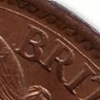|
|
The current range of books. Click the image above to see them on Amazon (printed and Kindle format). More info on coinpublications.com |
|
|
-
Content Count
2,538 -
Joined
-
Last visited
-
Days Won
162
Posts posted by secret santa
-
-
I have 2 N over Z pennies, the first showing the start of a die flaw by the 2nd N of PENNY and the second has a much more developed flaw showing it to be a later strike.
I'll attach photos together with the relevant obverses (one of which has the rotated R) to demonstrate Rob's point.
Earlier coin
Later coin with rotated R
Thus the rotated R is a later die.
-
Gary, if I were offered either of your specimens 2 or 3 I don't I'd accept them as dot varieties from those pictures. Maybe they look different in hand ?
-
Just checked my spares and I have an 1890 with a slightly rotated E too.
-
Keep the images coming, Ian - really useful. I've checked back through all my obverse R (Freeman 12) varieties from 1882 to 1894 and there is a mix of the the R & E touching and R & E apart. My 3 specimens of 1889 F128 (obverse S) all have the R & E touching like your picture above. I've updated my varieties website to record this.
-
7 hours ago, terrysoldpennies said:Hi Richard . That's what I was still researching . It seems to follow with the 15 tooth types, but the 16 tooth wide dates are type R with the extra leaf and the R and E are touching. So it will take a lot more coins with the extra leaf showing to make it clear which is which. Terry
So that's blown my theory out of the water if you have obverses with the additional leaf (obverse R) but R and E touching.
I'm trying to avoid the whole reverse/date width issue at the moment - merely looking at the 2 obverses. In fact, I've now checked a lot of other obverse R coins, given that R was used from 1882 to 1894 and there are versions with R and E separated and versions with them touching - so ignore my previous red herring about the gap being indicative of Obv R !!!! Back to the drawing board.....................
-
I believe that Terry may have unwittingly discovered another difference between Gouby obverses R and S. I previously thought that the extra leaf was the only difference, which made it very difficult to distinguish between varieties on worn examples. But, having looked again after terry's post above, it appears to me that obverse R has the R and E of REG separated by a definite gap whereas obverse S has the R and E virtually touching. I only have a few examples of each but so far this difference is consistent. Could other collectors please check their coins for me. This could prove to be an effective means of distinguishing between R and S (Freeman 12 and 13) on worn specimens.
-
Good man Steve and best of luck with the auction, although you won't need it !!!!!

-
That seems to be what the evidence currently suggests ? Interestingly, when I recorded the Crocker specimen (which I bought) in my collection details, I recorded it as obverse R, although it's too worn to be sure.
-
Did Michael say why he he had assigned the wide reverse to 1889C ? i.e. was he sure that it had obverse S ? The photo in his book appears to be from a worn coin whose obverse would be difficult to ascertain. In fact, given that the narrower date 1889B is paired with obv R, isn't it more likely that further date variations would also be on the same die pairing ?
-
His updated front page does say that the website is no longer live. A bit short-sighted as it makes an excellent advert for the coins. I doubt that Colin Cooke's pictures will do it justice.
-
I now find that I can't view this site other than home page - are other people having trouble ?
-
You can view the coins on the owner(forum member)'s website.
-
3 hours ago, PWA 1967 said:Penny collection for auction next month by Colin cooke.
Advertised in this months coin news and a collection i have viewed many times on the internet

Some cracking coins in that collection !!!!!!!

-
Coinery, are all these Edward VII coins in your possession ?
-
On 4/15/2016 at 2:30 PM, davidrj said:Thanks for that Gary, best article on threepences I've seen, may even think about getting some, they seem relatively cheap
Quality article - the header implies that there is a bronze penny article ? If so, I'd love to see it.
-
 1
1
-
-
I can't believe that a coin worth less than £10K 13 years ago can be worth over 4 times that now !!! But someone will probably cough up

-
12 hours ago, The Coinery said:Thank you Secret Santa - Will you send me 4 sovereigns this Christmas ?
No - four candles maybe.........
-
 1
1
-
-
I agree - thumb short of the cross.
-
Welcome to another penny man !!!
-
 1
1
-
-
Yes, it was that blob of light on the tail of the 3 that threw me.
-
Don't like to pour cold water on, but I'm not convinced it's an open 3.................
-
Do they allow visitors to take photos ?
-
Got 2 B of B 50p coins today in the Cotswolds.
-
Nice story
-
 1
1
-
 Coinpublications.com
Coinpublications.com


More Pennies
in British Coin Related Discussions & Enquiries
Posted
I don't trust "specimen" strikes...........